1.关于Ioc容器
(1)Ioc容器作用
最主要是完成了对象的创建和依赖的管理注入等
(2)换个视角来考虑
所谓的控制反转,就是把原先我们代码里面需要实现的对象创建、依赖的代码,反转给容器帮忙来实现。那么必然的我们需要创建一个容器,同时需要一种描述来让容器知道需要创建的对象与对象的关系。这个描述最具体的表现就是我们的配置文件。那么就会有以下2个问题:
1.对象和对象的关系怎么表示?
可以用xml,properties等文件表示
2.描述对象关系的文件放在哪里?
可能是classpath,fileSystem,或者是URL网络资源,ServletContext等
有了配置文件,还需要对配置文件进行解析,解析过程中可能又会遇到以下几个问题
1.不同的配置文件对对象的描述不一样,如标准的,自定义声明式的,如何统一?
使用Resource接口来统一
2.在内部需要有一个统一的关于对象的定义
统一使用BeanDefinition
3.如何对不同的配置文件进行解析?
使用BeanDefinitionReader和BeanFactory
4.需要对不同的配置文件语法,采用不同解析方式?
使用ApplicationContext
以上5个全是接口,都有各式各样的实现,正是这5个接口定义了spring ioc容器的基本代码组件结构,而其组件各种实现的组合关系组成了一个运行时的具体容器。
2.各组件详解
(1)Resource
是对资源的抽象,每一个接口实现类都代表了一种资源类型,如ClasspathResource、URLResource、FileSystemResource等。每一个资源类型都封装了对某一种特定资源的访问策略。它是spring资源访问策略的一个基础实现,应用在很多场景。
(2)BeanDefinition
又来抽象和描述一个具体bean对象。是描述一个bean对象的基本数据结构
(3)BeanDefinitionReader
将外部资源对象描述的bean定义,统一转化为统一个内部数据结构BeanDefinition。对应不同的描述需要有不同的Reader。如XMLBeanDefinitionReader用来读取xml描述配置的bean对象
(4)BeanFactory
用来定义一个很纯粹的bean容器,它是一个bean容器的必备结构。同时和外部应用环境等隔离。BeanDefinition是它的基本数据结构。他维护一个BeanDefinitions Map,并可以根据BeanDefinition的描述进行bean的创建和管理。
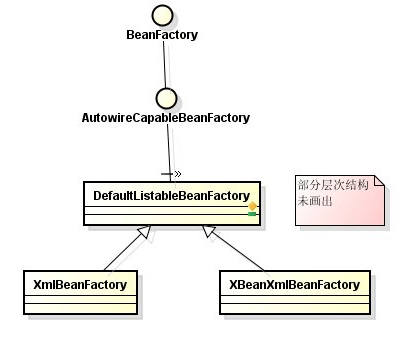
(5)ApplicationContext
从名字上来看叫做应用上下文,是和应用环境息息相关的。这个就是我们平时开发中经常直接使用的一个类,应用上下文,或者也叫做spring容器。其实它的基本实现是会持有一个BeanFactory对象,并基于此提供一些包装和功能扩展。为什么要这么做呢?因为BeanFactory实现了一个容器基本结构和功能,但是与外部环境隔离。那么读取配置文件,并将配置文件解析成BeanDefinition,然后注册到BeanFactory的这一个过程的封装自然就需要ApplicationContext。ApplicationContext和应用环境息息相关,常见的实现类有ClassPathXMLApplicationContext、FileSystemXMLApplicationContext、WebApplicationContext等。ClassPath、xml、FileSystem等词都代表了应用和环境相关的一些意思。
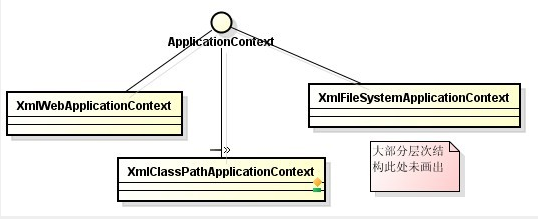
以上5个组件基本代表了ioc容器的一个最基本组成,而组件的组合是放在ApplicationContext的实现这一层来完成的
以ClassPathXMLApplicationContext为例,展示5个组件的组合关系
3.解析配置文件过程
(1)基本步骤
1)把xml配置文件转换成Resource。
Resource的转换时先通过ResourcePatternResolver来解析可识别格式的配置文件的路径(如"classpath:"等),如果没有指定格式,默认会按照类路径的资源来处理。
2)利用XMLBeanDefinitionReader完成对xml的解析,将xml Resource中定义的bean对象统一转换成统一的BeanDefinition。
3)将BeanDefinition注册到BeanFactory,完成对BeanFactory的初始化。BeanFactory中会维护一个BeanDefinition的Map
(2)详细步骤1)创建一个ClasspathXmlApplicationContext对象,传入文件名称。
ClassPathXmlApplicationContext re = new ClassPathXmlApplicationContext("applicationContext.xml"); 2)ClasspathXmlApplicationContext中有多个构造方法,但是都会重载到下面的方法
public ClassPathXmlApplicationContext(String[] configLocations, boolean refresh, ApplicationContext parent)
throws BeansException
{
super(parent);
setConfigLocations(configLocations);
if (refresh)
{
refresh();
}
} 为什么叫refresh?其实也就是刷新的意思,该ioc容器里面维护了一个单例的BeanFactory,如果bean的配置有修改,也可以直接调用refresh方法,它将销毁之前的BeanFactory,重新创建一个BeanFactory。所以叫refresh也是可以理解的。
3)refresh方法由AbstractApplicationContext实现
public void refresh() throws BeansException, IllegalStateException
{
synchronized (this.startupShutdownMonitor)
{
// Prepare this context for refreshing.
prepareRefresh();
// Tell the subclass to refresh the internal bean factory.
ConfigurableListableBeanFactory beanFactory = obtainFreshBeanFactory();
// Prepare the bean factory for use in this context.
prepareBeanFactory(beanFactory);
try
{
// Allows post-processing of the bean factory in context subclasses.
postProcessBeanFactory(beanFactory);
// Invoke factory processors registered as beans in the context.
invokeBeanFactoryPostProcessors(beanFactory);
// Register bean processors that intercept bean creation.
registerBeanPostProcessors(beanFactory);
// Initialize message source for this context.
initMessageSource();
// Initialize event multicaster for this context.
initApplicationEventMulticaster();
// Initialize other special beans in specific context subclasses.
onRefresh();
// Check for listener beans and register them.
registerListeners();
// Instantiate all remaining (non-lazy-init) singletons.
finishBeanFactoryInitialization(beanFactory);
// Last step: publish corresponding event.
finishRefresh();
}
catch (BeansException ex)
{
logger.warn("Exception encountered during context initialization - cancelling refresh attempt", ex);
// Destroy already created singletons to avoid dangling resources.
destroyBeans();
// Reset 'active' flag.
cancelRefresh(ex);
// Propagate exception to caller.
throw ex;
}
}
} 4)启动对BeanDefinition的载入
还是在ApplicationContext类中
protected ConfigurableListableBeanFactory obtainFreshBeanFactory()
{
refreshBeanFactory();
ConfigurableListableBeanFactory beanFactory = getBeanFactory();
if (logger.isDebugEnabled())
{
logger.debug("Bean factory for " + getDisplayName() + ": " + beanFactory);
}
return beanFactory;
} protected final void refreshBeanFactory() throws BeansException
{
if (hasBeanFactory())
{
destroyBeans();
closeBeanFactory();
}
try
{
DefaultListableBeanFactory beanFactory = createBeanFactory();
beanFactory.setSerializationId(getId());
customizeBeanFactory(beanFactory);
loadBeanDefinitions(beanFactory);
synchronized (this.beanFactoryMonitor)
{
this.beanFactory = beanFactory;
}
}
catch (IOException ex)
{
throw new ApplicationContextException("I/O error parsing bean definition source for " + getDisplayName(), ex);
}
}第二步就是创建各种ApplicationContext持有的真正容器实现类DefaultListableBeanFactory,创建ioc容器
最后启动BeanDefinition的载入 loadBeanDefinitions(beanFactory)方法
5)BeanFactory将载入工作交给BeanDefinitionReader
loadBeanDefinitions(beanFactory)方法是抽象的,又因为我们的配置文件是xml格式的,所以具体实现是在AbstractXmlApplicationContext中
protected void loadBeanDefinitions(DefaultListableBeanFactory beanFactory) throws BeansException, IOException
{
// Create a new XmlBeanDefinitionReader for the given BeanFactory.
XmlBeanDefinitionReader beanDefinitionReader = new XmlBeanDefinitionReader(beanFactory);
// Configure the bean definition reader with this context's
// resource loading environment.
beanDefinitionReader.setEnvironment(this.getEnvironment());
beanDefinitionReader.setResourceLoader(this);
beanDefinitionReader.setEntityResolver(new ResourceEntityResolver(this));
// Allow a subclass to provide custom initialization of the reader,
// then proceed with actually loading the bean definitions.
initBeanDefinitionReader(beanDefinitionReader);
loadBeanDefinitions(beanDefinitionReader);
} protected void loadBeanDefinitions(XmlBeanDefinitionReader reader) throws BeansException, IOException
{
Resource[] configResources = getConfigResources();
if (configResources != null)
{
reader.loadBeanDefinitions(configResources);
}
String[] configLocations = getConfigLocations();
if (configLocations != null)
{
reader.loadBeanDefinitions(configLocations);
}
} public int loadBeanDefinitions(Resource... resources) throws BeanDefinitionStoreException
{
Assert.notNull(resources, "Resource array must not be null");
int counter = 0;
for (Resource resource : resources)
{
counter += loadBeanDefinitions(resource);
}
return counter;
} public int loadBeanDefinitions(Resource resource) throws BeanDefinitionStoreException
{
return loadBeanDefinitions(new EncodedResource(resource));
} public int loadBeanDefinitions(EncodedResource encodedResource) throws BeanDefinitionStoreException
{
Assert.notNull(encodedResource, "EncodedResource must not be null");
if (logger.isInfoEnabled())
{
logger.info("Loading XML bean definitions from " + encodedResource.getResource());
}
Set<EncodedResource> currentResources = this.resourcesCurrentlyBeingLoaded.get();
if (currentResources == null)
{
currentResources = new HashSet<EncodedResource>(4);
this.resourcesCurrentlyBeingLoaded.set(currentResources);
}
if (!currentResources.add(encodedResource))
{
throw new BeanDefinitionStoreException(
"Detected cyclic loading of " + encodedResource + " - check your import definitions!");
}
try
{
InputStream inputStream = encodedResource.getResource().getInputStream();
try
{
InputSource inputSource = new InputSource(inputStream);
if (encodedResource.getEncoding() != null)
{
inputSource.setEncoding(encodedResource.getEncoding());
}
return doLoadBeanDefinitions(inputSource, encodedResource.getResource());
}
finally
{
inputStream.close();
}
}
catch (IOException ex)
{
throw new BeanDefinitionStoreException(
"IOException parsing XML document from " + encodedResource.getResource(), ex);
}
finally
{
currentResources.remove(encodedResource);
if (currentResources.isEmpty())
{
this.resourcesCurrentlyBeingLoaded.remove();
}
}
}
6)XMLBeanDefinitionReader将载入工作交给W3C的dom
因为读入的文件是xml格式的,所以底层的实现肯定是要和W3C的dom打交道
/**
* Actually load bean definitions from the specified XML file.
* @param inputSource the SAX InputSource to read from
* @param resource the resource descriptor for the XML file
* @return the number of bean definitions found
* @throws BeanDefinitionStoreException in case of loading or parsing errors
*/
protected int doLoadBeanDefinitions(InputSource inputSource, Resource resource)
throws BeanDefinitionStoreException
{
try
{
int validationMode = getValidationModeForResource(resource);
Document doc = this.documentLoader.loadDocument(
inputSource, getEntityResolver(), this.errorHandler, validationMode, isNamespaceAware());
return registerBeanDefinitions(doc, resource);
}
catch (BeanDefinitionStoreException ex)
{
throw ex;
}
catch (SAXParseException ex)
{
throw new XmlBeanDefinitionStoreException(resource.getDescription(),
"Line " + ex.getLineNumber() + " in XML document from " + resource + " is invalid", ex);
}
catch (SAXException ex)
{
throw new XmlBeanDefinitionStoreException(resource.getDescription(),
"XML document from " + resource + " is invalid", ex);
}
catch (ParserConfigurationException ex)
{
throw new BeanDefinitionStoreException(resource.getDescription(),
"Parser configuration exception parsing XML from " + resource, ex);
}
catch (IOException ex)
{
throw new BeanDefinitionStoreException(resource.getDescription(),
"IOException parsing XML document from " + resource, ex);
}
catch (Throwable ex)
{
throw new BeanDefinitionStoreException(resource.getDescription(),
"Unexpected exception parsing XML document from " + resource, ex);
}
} /**
* Register the bean definitions contained in the given DOM document.
* @param doc the DOM document
* @param resource the resource descriptor (for context information)
* @return the number of bean definitions found
* @throws BeanDefinitionStoreException in case of parsing errors
*/
@SuppressWarnings("deprecation")
public int registerBeanDefinitions(Document doc, Resource resource) throws BeanDefinitionStoreException
{
BeanDefinitionDocumentReader documentReader = createBeanDefinitionDocumentReader();
documentReader.setEnvironment(getEnvironment());
int countBefore = getRegistry().getBeanDefinitionCount();
documentReader.registerBeanDefinitions(doc, createReaderContext(resource));
return getRegistry().getBeanDefinitionCount() - countBefore;
}
7)BeanDefinitionDocumentReader将载入工作交给代理类BeanDefinitionParserDelegate
public void registerBeanDefinitions(Document doc, XmlReaderContext readerContext)
{
this.readerContext = readerContext;
logger.debug("Loading bean definitions");
Element root = doc.getDocumentElement();
doRegisterBeanDefinitions(root);
} /**
* Register each bean definition within the given root {@code <beans/>} element.
*/
protected void doRegisterBeanDefinitions(Element root)
{
String profileSpec = root.getAttribute(PROFILE_ATTRIBUTE);
if (StringUtils.hasText(profileSpec))
{
String[] specifiedProfiles = StringUtils.tokenizeToStringArray(
profileSpec, BeanDefinitionParserDelegate.MULTI_VALUE_ATTRIBUTE_DELIMITERS);
if (!getEnvironment().acceptsProfiles(specifiedProfiles))
{
return;
}
}
BeanDefinitionParserDelegate parent = this.delegate;
this.delegate = createDelegate(this.readerContext, root, parent);
preProcessXml(root);
parseBeanDefinitions(root, this.delegate);
postProcessXml(root);
this.delegate = parent;
} /**
* Parse the elements at the root level in the document:
* "import", "alias", "bean".
* @param root the DOM root element of the document
*/
protected void parseBeanDefinitions(Element root, BeanDefinitionParserDelegate delegate)
{
if (delegate.isDefaultNamespace(root))
{
NodeList nl = root.getChildNodes();
for (int i = 0; i < nl.getLength(); i++)
{
Node node = nl.item(i);
if (node instanceof Element)
{
Element ele = (Element) node;
if (delegate.isDefaultNamespace(ele))
{
parseDefaultElement(ele, delegate);
}
else
{
delegate.parseCustomElement(ele);
}
}
}
}
else
{
delegate.parseCustomElement(root);
}
} private void parseDefaultElement(Element ele, BeanDefinitionParserDelegate delegate)
{
if (delegate.nodeNameEquals(ele, IMPORT_ELEMENT))
{
importBeanDefinitionResource(ele);
}
else if (delegate.nodeNameEquals(ele, ALIAS_ELEMENT))
{
processAliasRegistration(ele);
}
else if (delegate.nodeNameEquals(ele, BEAN_ELEMENT))
{
processBeanDefinition(ele, delegate);
}
else if (delegate.nodeNameEquals(ele, NESTED_BEANS_ELEMENT))
{
// recurse
doRegisterBeanDefinitions(ele);
}
} protected void processBeanDefinition(Element ele, BeanDefinitionParserDelegate delegate)
{
BeanDefinitionHolder bdHolder = delegate.parseBeanDefinitionElement(ele);
if (bdHolder != null)
{
bdHolder = delegate.decorateBeanDefinitionIfRequired(ele, bdHolder);
try
{
// Register the final decorated instance.
BeanDefinitionReaderUtils.registerBeanDefinition(bdHolder, getReaderContext().getRegistry());
}
catch (BeanDefinitionStoreException ex)
{
getReaderContext().error("Failed to register bean definition with name '" +
bdHolder.getBeanName() + "'", ele, ex);
}
// Send registration event.
getReaderContext().fireComponentRegistered(new BeanComponentDefinition(bdHolder));
}
}以下就是一些xml的解析工作。
8)BeanDefinition的解析主要在BeanDefinitionParserDelegate的ParserBeanDefinitionElement()方法中进行
public BeanDefinitionHolder parseBeanDefinitionElement(Element ele, BeanDefinition containingBean)
{
String id = ele.getAttribute(ID_ATTRIBUTE);
String nameAttr = ele.getAttribute(NAME_ATTRIBUTE);
List<String> aliases = new ArrayList<String>();
if (StringUtils.hasLength(nameAttr))
{
String[] nameArr = StringUtils.tokenizeToStringArray(nameAttr, MULTI_VALUE_ATTRIBUTE_DELIMITERS);
aliases.addAll(Arrays.asList(nameArr));
}
String beanName = id;
if (!StringUtils.hasText(beanName) && !aliases.isEmpty())
{
beanName = aliases.remove(0);
if (logger.isDebugEnabled())
{
logger.debug("No XML 'id' specified - using '" + beanName +
"' as bean name and " + aliases + " as aliases");
}
}
if (containingBean == null)
{
checkNameUniqueness(beanName, aliases, ele);
}
AbstractBeanDefinition beanDefinition = parseBeanDefinitionElement(ele, beanName, containingBean);
if (beanDefinition != null)
{
if (!StringUtils.hasText(beanName))
{
try
{
if (containingBean != null)
{
beanName = BeanDefinitionReaderUtils.generateBeanName(
beanDefinition, this.readerContext.getRegistry(), true);
}
else
{
beanName = this.readerContext.generateBeanName(beanDefinition);
// Register an alias for the plain bean class name, if still possible,
// if the generator returned the class name plus a suffix.
// This is expected for Spring 1.2/2.0 backwards compatibility.
String beanClassName = beanDefinition.getBeanClassName();
if (beanClassName != null &&
beanName.startsWith(beanClassName) && beanName.length() > beanClassName.length() &&
!this.readerContext.getRegistry().isBeanNameInUse(beanClassName))
{
aliases.add(beanClassName);
}
}
if (logger.isDebugEnabled())
{
logger.debug("Neither XML 'id' nor 'name' specified - " +
"using generated bean name [" + beanName + "]");
}
}
catch (Exception ex)
{
error(ex.getMessage(), ele);
return null;
}
}
String[] aliasesArray = StringUtils.toStringArray(aliases);
return new BeanDefinitionHolder(beanDefinition, beanName, aliasesArray);
}
return null;
} public AbstractBeanDefinition parseBeanDefinitionElement(
Element ele, String beanName, BeanDefinition containingBean)
{
this.parseState.push(new BeanEntry(beanName));
String className = null;
if (ele.hasAttribute(CLASS_ATTRIBUTE))
{
className = ele.getAttribute(CLASS_ATTRIBUTE).trim();
}
try
{
String parent = null;
if (ele.hasAttribute(PARENT_ATTRIBUTE))
{
parent = ele.getAttribute(PARENT_ATTRIBUTE);
}
AbstractBeanDefinition bd = createBeanDefinition(className, parent);
parseBeanDefinitionAttributes(ele, beanName, containingBean, bd);
bd.setDescription(DomUtils.getChildElementValueByTagName(ele, DESCRIPTION_ELEMENT));
parseMetaElements(ele, bd);
parseLookupOverrideSubElements(ele, bd.getMethodOverrides());
parseReplacedMethodSubElements(ele, bd.getMethodOverrides());
parseConstructorArgElements(ele, bd);
parsePropertyElements(ele, bd);
parseQualifierElements(ele, bd);
bd.setResource(this.readerContext.getResource());
bd.setSource(extractSource(ele));
return bd;
}
catch (ClassNotFoundException ex)
{
error("Bean class [" + className + "] not found", ele, ex);
}
catch (NoClassDefFoundError err)
{
error("Class that bean class [" + className + "] depends on not found", ele, err);
}
catch (Throwable ex)
{
error("Unexpected failure during bean definition parsing", ele, ex);
}
finally
{
this.parseState.pop();
}
return null;
} /**
* Parse property sub-elements of the given bean element.
*/
public void parsePropertyElements(Element beanEle, BeanDefinition bd)
{
NodeList nl = beanEle.getChildNodes();
for (int i = 0; i < nl.getLength(); i++)
{
Node node = nl.item(i);
if (isCandidateElement(node) && nodeNameEquals(node, PROPERTY_ELEMENT))
{
parsePropertyElement((Element) node, bd);
}
}
} /**
* Parse a property element.
*/
public void parsePropertyElement(Element ele, BeanDefinition bd)
{
String propertyName = ele.getAttribute(NAME_ATTRIBUTE);
if (!StringUtils.hasLength(propertyName))
{
error("Tag 'property' must have a 'name' attribute", ele);
return;
}
this.parseState.push(new PropertyEntry(propertyName));
try
{
if (bd.getPropertyValues().contains(propertyName))
{
error("Multiple 'property' definitions for property '" + propertyName + "'", ele);
return;
}
Object val = parsePropertyValue(ele, bd, propertyName);
PropertyValue pv = new PropertyValue(propertyName, val);
parseMetaElements(ele, pv);
pv.setSource(extractSource(ele));
bd.getPropertyValues().addPropertyValue(pv);
}
finally
{
this.parseState.pop();
}
} /**
* Get the value of a property element. May be a list etc.
* Also used for constructor arguments, "propertyName" being null in this case.
*/
public Object parsePropertyValue(Element ele, BeanDefinition bd, String propertyName)
{
String elementName = (propertyName != null) ?
"<property> element for property '" + propertyName + "'" :
"<constructor-arg> element";
// Should only have one child element: ref, value, list, etc.
NodeList nl = ele.getChildNodes();
Element subElement = null;
for (int i = 0; i < nl.getLength(); i++)
{
Node node = nl.item(i);
if (node instanceof Element && !nodeNameEquals(node, DESCRIPTION_ELEMENT) &&
!nodeNameEquals(node, META_ELEMENT))
{
// Child element is what we're looking for.
if (subElement != null)
{
error(elementName + " must not contain more than one sub-element", ele);
}
else
{
subElement = (Element) node;
}
}
}
boolean hasRefAttribute = ele.hasAttribute(REF_ATTRIBUTE);
boolean hasValueAttribute = ele.hasAttribute(VALUE_ATTRIBUTE);
if ((hasRefAttribute && hasValueAttribute) ||
((hasRefAttribute || hasValueAttribute) && subElement != null))
{
error(elementName +
" is only allowed to contain either 'ref' attribute OR 'value' attribute OR sub-element", ele);
}
if (hasRefAttribute)
{
String refName = ele.getAttribute(REF_ATTRIBUTE);
if (!StringUtils.hasText(refName))
{
error(elementName + " contains empty 'ref' attribute", ele);
}
RuntimeBeanReference ref = new RuntimeBeanReference(refName);
ref.setSource(extractSource(ele));
return ref;
}
else if (hasValueAttribute)
{
TypedStringValue valueHolder = new TypedStringValue(ele.getAttribute(VALUE_ATTRIBUTE));
valueHolder.setSource(extractSource(ele));
return valueHolder;
}
else if (subElement != null)
{
return parsePropertySubElement(subElement, bd);
}
else
{
// Neither child element nor "ref" or "value" attribute found.
error(elementName + " must specify a ref or value", ele);
return null;
}
} /**
* Parse a value, ref or collection sub-element of a property or
* constructor-arg element.
* @param ele subelement of property element; we don't know which yet
* @param defaultValueType the default type (class name) for any
* {@code <value>} tag that might be created
*/
public Object parsePropertySubElement(Element ele, BeanDefinition bd, String defaultValueType)
{
if (!isDefaultNamespace(ele))
{
return parseNestedCustomElement(ele, bd);
}
else if (nodeNameEquals(ele, BEAN_ELEMENT))
{
BeanDefinitionHolder nestedBd = parseBeanDefinitionElement(ele, bd);
if (nestedBd != null)
{
nestedBd = decorateBeanDefinitionIfRequired(ele, nestedBd, bd);
}
return nestedBd;
}
else if (nodeNameEquals(ele, REF_ELEMENT))
{
// A generic reference to any name of any bean.
String refName = ele.getAttribute(BEAN_REF_ATTRIBUTE);
boolean toParent = false;
if (!StringUtils.hasLength(refName))
{
// A reference to the id of another bean in the same XML file.
refName = ele.getAttribute(LOCAL_REF_ATTRIBUTE);
if (!StringUtils.hasLength(refName))
{
// A reference to the id of another bean in a parent context.
refName = ele.getAttribute(PARENT_REF_ATTRIBUTE);
toParent = true;
if (!StringUtils.hasLength(refName))
{
error("'bean', 'local' or 'parent' is required for <ref> element", ele);
return null;
}
}
}
if (!StringUtils.hasText(refName))
{
error("<ref> element contains empty target attribute", ele);
return null;
}
RuntimeBeanReference ref = new RuntimeBeanReference(refName, toParent);
ref.setSource(extractSource(ele));
return ref;
}
else if (nodeNameEquals(ele, IDREF_ELEMENT))
{
return parseIdRefElement(ele);
}
else if (nodeNameEquals(ele, VALUE_ELEMENT))
{
return parseValueElement(ele, defaultValueType);
}
else if (nodeNameEquals(ele, NULL_ELEMENT))
{
// It's a distinguished null value. Let's wrap it in a TypedStringValue
// object in order to preserve the source location.
TypedStringValue nullHolder = new TypedStringValue(null);
nullHolder.setSource(extractSource(ele));
return nullHolder;
}
else if (nodeNameEquals(ele, ARRAY_ELEMENT))
{
return parseArrayElement(ele, bd);
}
else if (nodeNameEquals(ele, LIST_ELEMENT))
{
return parseListElement(ele, bd);
}
else if (nodeNameEquals(ele, SET_ELEMENT))
{
return parseSetElement(ele, bd);
}
else if (nodeNameEquals(ele, MAP_ELEMENT))
{
return parseMapElement(ele, bd);
}
else if (nodeNameEquals(ele, PROPS_ELEMENT))
{
return parsePropsElement(ele);
}
else
{
error("Unknown property sub-element: [" + ele.getNodeName() + "]", ele);
return null;
}
}







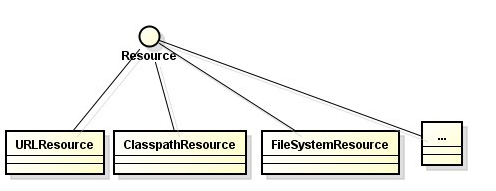
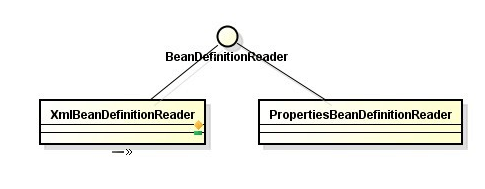
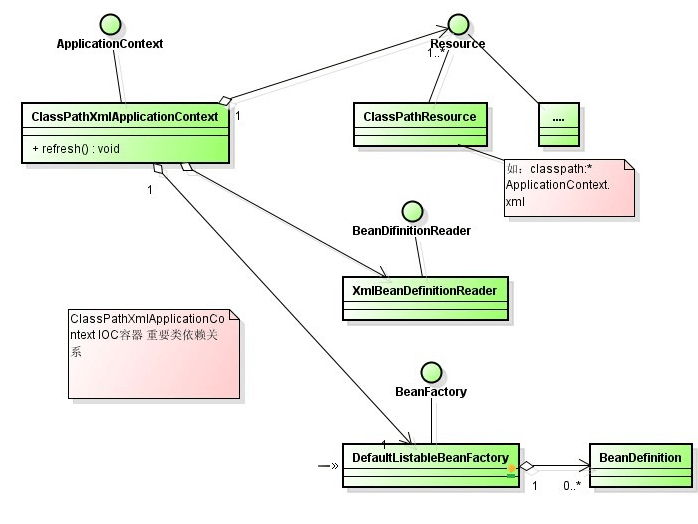













 2283
2283











 被折叠的 条评论
为什么被折叠?
被折叠的 条评论
为什么被折叠?








